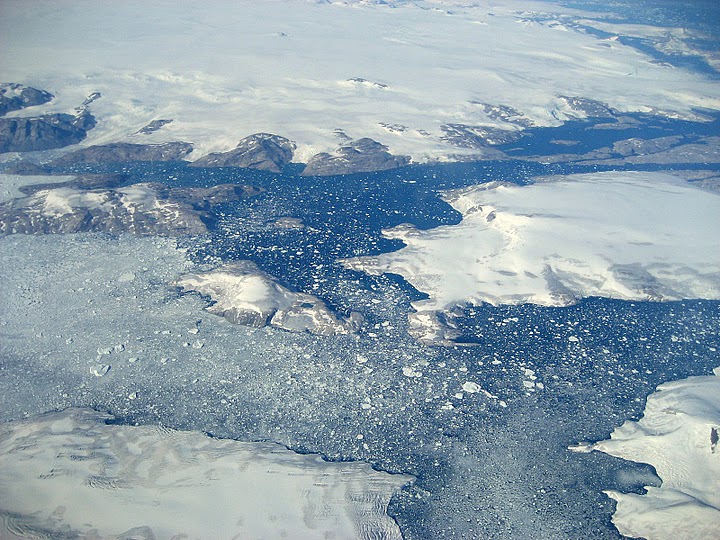The amazing amount of press coverage for one large iceberg this summer was indicative of how poorly educated the public is.
The photo above was taken flying over southeast Greenland in August 2008. The ocean there is typically full of icebergs. When snow falls in the interior of Greenland, it piles up and the pressure forces the ice (glaciers) outwards towards the sea. When the ice reaches the sea, it calves off into icebergs. Icebergs are just a part of the equilibrium cycle.
Southeast Greenland receives snow almost continuously, so the icebergs keep coming, year in and year out. If they didn’t, the ice in Greenland would be many miles thick.
http://www.snow-forecast.com/maps/static/europe/last3days/snow




We need more info, this can hardly be called a blog post. How are Greenland’s glaciers doing? Tell us about Jakobshavn, Helheim, Kangerddlugsuaq, Zachariae, Petermann, Humboldt, etc.
Neven
Chunks breaking off the Petermann Glacier are not unusual, and there was little or no discussion about that.
http://wattsupwiththat.com/2010/07/13/greenlands-jakobshavn-glacier-retreat/
You’re absolutely right. 250 square km chunks break off every week.
Nature is full of hysteresis. Tension builds up over a long period of time, followed by a sudden release. Ice shelves do this, as do volcanoes and strike slip faults like the San Andreas.
If you take a long term view, 250 square km chunks breaking off is not unusual. But the world is full of neo-scientists who just checked in recently, and get alarmed easily.
But the world is full of neo-scientists who just checked in recently, and get alarmed easily.
Well, pardon me, Steven, but when I read what the experts – with decades of experience in monitoring glaciers – have to say about Petermann Glacier (and other Greenland glaciers) I don’t think your playing down holds any merit. Maybe if you try to write a blog post with more than 500 words you can manage to convince us everything is just fine with (Greenland) glaciers. But you can’t, because you have zero evidence.
Other than that, the satellite images from the breaking off of the Petermann Ice Island and subsequent travel of the enormous ice mass is just plain spectacular. It was only normal it got some traction in the media, as it was the biggest iceberg breaking off, in what, 50 years?
Neven, was the “50 years” comment meant to be sarcasm? I hope so because fifty years isn’t even a nanosecond in time.
So when the biggest piece of glacier in 50 years breaks off the media are not allowed to report on it? Where’s the logic in that?
copied from the summary of the second link;
“Losses at the front of glaciers translate to less ice flow-resistance and in turn accelerated flow. Flow acceleration leads to further thinning by stretching. In turn the “grounding line”, where the glacier begins to float migrates inland. For the largest glaciers that have bedrock trenches leading inland to the thickest parts of the ice sheet, there is no expected mechanism to prevent retreat from …”
so am I to understand, the floating end of a glacier imposes a great deal of drag on the back of the glacier? Wouldn’t it just as likely have a pulling effect on the back end of the glacier? In any event I believe elevation and gravity have a bigger “pull” than floating bits.
am I to understand
This is indeed the big question. The way you write you sound like the world’s foremost expert on glaciers. I guess you think you’re one of those people who already know everything by doing a minimum of research.
Neven,
Do you have any reason to believe of the size of the break is related to the CO2 content of the atmosphere?
A clean fracture occurred in a 700 foot thick piece of ice. The ice didn’t melt, it was a mechanical break.
If ice sheets melt, they do not need to fracture, the weight on the lever is reduced. The fact that the sheet grew enough to fracture indicates that melting was reduced enough for the end weight to produce the force necessary for fracture.
During the warm period after 1970, we had no fracture because the sheet was not able to propagate faster than melting episodes were able reduce the force applied at the terminus.
Large ice sheet fractures are a good indicator that a cold period has begun.
I meant “for the end weight no longer being sufficient to produce the force necessary for fracture”. Sorry.
Nevin:
One does not have to be an “expert” to understand the same grade-school physics that Archimedes understood. Eureka! Excelsior! (h/t to Stan Lee)